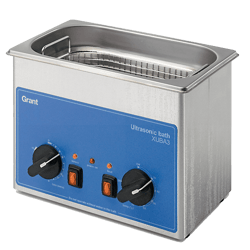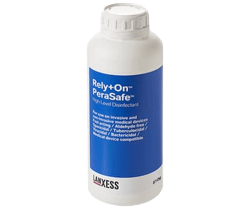How to sterilize PIC transfers
PIC transfers can be sterilized in 3 different ways: with Rely+On™ PeraSafe™ (CE approved), with Revital-Ox® RESERT® (FDA approved) and with steam (autoclave).
For more information, access the PIC transfers instructions for use (IFU).
Cleaning before sterilizing
Before proceeding with any of the sterilization protocols, you must first clean the PIC transfers. Cleaning removes all solid residue and is mandatory to ensure that the sterilization reaches all the surfaces of a PIC transfer.
Cleaning is done in two steps: preliminary cleaning (removal of debris) and ultrasonic bath cleaning
STEP 1) Preliminary cleaning
Materials needed
- Appropriate protective equipment: gloves, face mask, scrubs
- Tweezers
- Non-abrasive cleaning tools such as soft interdental brushes
- Water: Use cold deionized or reverse osmosis-purified water. Avoid temperatures above 60 °C to prevent protein coagulation and ensure effective removal from contaminated items.
 Use the tweezers to remove the screw, leaving the PIC transfer screen channel free for cleaning
Use the tweezers to remove the screw, leaving the PIC transfer screen channel free for cleaning Use the brush to clean contact areas, such as threads, cavities, and blind holes to remove all visible dirt and debris. Ensure the cleaning process exposes all PIC transfer parts as per their geometry.
Use the brush to clean contact areas, such as threads, cavities, and blind holes to remove all visible dirt and debris. Ensure the cleaning process exposes all PIC transfer parts as per their geometry.- Rinse PIC transfers with deionized water
STEP 2) Ultrasonic bath cleaning
Materials needed

- Ultrasonic bath
- Water: Use cold deionized or reverse osmosis-purified water. Avoid temperatures above 60 °C to prevent protein coagulation and ensure effective removal from contaminated items.
- Medical grade detergent (neutral pH): Prepare according to the manufacturer's guidelines.
Ensure the ultrasonic bath is clean and functional, and then follow the steps below:
- Fill the ultrasonic bath. Add the manufacturer-recommended quantity of detergent.
- Fully submerge the PIC transfers in the ultrasonic bath without overcrowding.
- Start the ultrasonic cleaning cycle following the equipment's user manual.
-
The ultrasonic bath will generate high-frequency sound waves that create microscopic bubbles. As these bubbles implode, they release energy that helps dislodge and remove contaminants from the instruments.
-
After the ultrasonic cleaning cycle, remove the PIC transfers from the bath.
-
If the ultrasonic bath equipment has a drying function, you can use it to dry the cleaned PIC transfers. Alternatively, you can use a separate drying process (e.g., using a fiber-free cloth or dry compressed air).
-
Visually inspect the PIC transfers for any remaining debris or contamination. If needed, repeat the cleaning process.
Sterilization
After the cleaning steps are completed, there are three approved methods to sterilize PIC transfers: two cold sterilization options and steam sterilization.
What is cold sterilization?
Cold sterilization is a method of sterilization that consists of a reusable medical instrument immersed in an approved liquid chemical.
This process is referred to as cold sterilization because it can be done at room temperature. It can only be performed with reusable medical instruments.
Cold sterilization is recommended for sterilizing PIC transfers, as it's a fast method that doesn't require additional devices.
Rely+On™ PeraSafe™ (CE approved)

PIC transfer reprocessing has been validated for high-level disinfection, within the European Union (CE mark, Regulation EU 2017/745), with Rely+On™ PeraSafe™ disinfectant. The instructions for use of the disinfectant's manufacturer must be strictly followed.
FULL ARTICLE: Sterilization protocol with Rely+On™ PeraSafe™: step-by-step
Revital-Ox® RESERT® (FDA approved)
.png?width=250&height=142&name=2024-02%20-%20PIC%20transfer%20IFU%20(RevitalOx).png) PIC transfer reprocessing has been validated for high-level disinfection, within the USA (FDA, 21 CFR 800), with Revital-Ox® RESERT® disinfectant. The instructions for use of the disinfectant's manufacturer must be strictly followed.
PIC transfer reprocessing has been validated for high-level disinfection, within the USA (FDA, 21 CFR 800), with Revital-Ox® RESERT® disinfectant. The instructions for use of the disinfectant's manufacturer must be strictly followed.
FULL ARTICLE: Sterilization protocol with Revital-Ox® RESERT®: step-by-step
Steam sterilization (Autoclave)
 PIC transfer reprocessing has been validated for steam sterilization with the sterilization protocol provided in the instructions for use.
PIC transfer reprocessing has been validated for steam sterilization with the sterilization protocol provided in the instructions for use.
FULL ARTICLE: Sterilization protocol with steam (autoclave): step-by-step